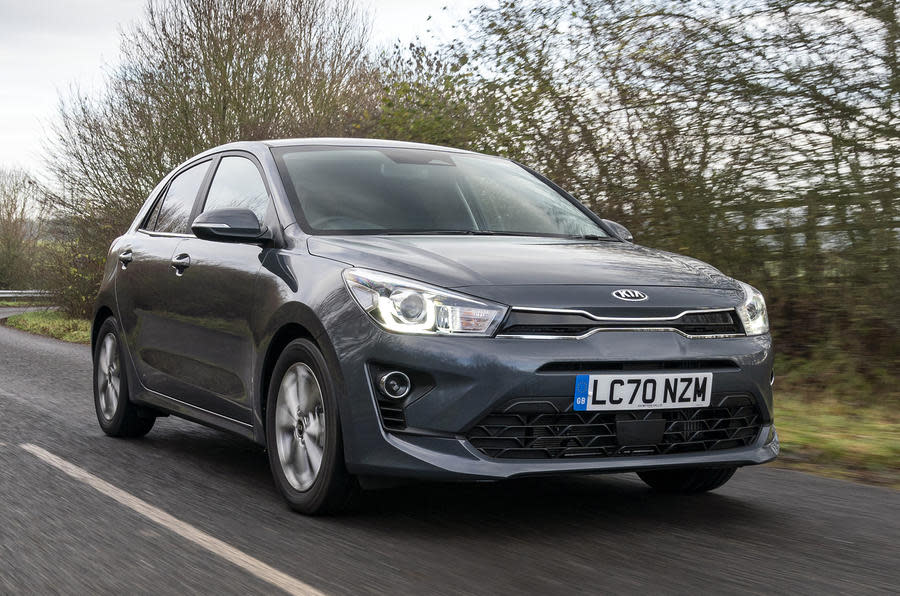Kia Rio

The Kia Rio is now one of the biggest-selling global models of the world’s third-largest car-making group, worth almost half a million annual sales to Kia .
The car has a much greater profile elsewhere in the world than it has here in Europe, where, despite consistent sales growth, it has yet to break into the top 10 best-selling cars in the supermini class, and it remains out-sold by both the Kia Kia Ceed and Kia Sportage.
You don’t come by a top-10 place in the European supermini sales charts easily, of course.
In order to earn one, the Rio needs to displace a more established European-built small cars, such as the Seat Ibiza, Citroën C3, Peugeot 208 or Skoda Fabia (it already sells better than the Mazda 2, Honda Jazz and Nissan Micra).
With that in mind, slowly but surely over the past couple of revisions and not at all by coincidence, the Rio has begun to feel more and more like a small car tailored to European tastes – and this latest version develops that trend.
Now in its fourth model generation and recently facelifted for the 2021-model-year, this new Rio is outwardly a match for the pre-facelifted version, although Kia claims that it has gained a little on cabin space. It was designed by teams working in parallel at Kia’s design centre in Germany and North America charged with the idea of making it look more cleanly and sharply cut, and more smoothly surfaced, than it used to. A revised 'tiger nose' front grille and bumpers are among the features new to the latest version.
Under the bonnet, the car gets a choice of very Europe-focused petrol engines: a pair of new 1.0-litre turbocharged three-pot petrols making 99bhp or 118bhp (the latter being available for the first time as a 48-volt mild hybrid), and a cheaper 1.2-litre naturally aspirated four-cylinder petrol with 83bhp. Diesel engines were discontinued for the car's 2018-model-year, and so only very briefly figured in the fourth-generation car. Both manual and seven-speed twin-clutch automatic gearboxes are on offer in the Rio, depending on selected engine.
That's a powertrain lineup that promises to bring the Rio bang up to date and in line with the likes of the Volkswagen Polo, Ford Fiesta and Renault Clio on driveability, economy and emissions.
Inside the cabin there’s a new ergonomic approach to the fascia design and a focus on new connectivity features, while Kia's very latest infotainment system has now been added to the car also.
Perhaps most interesting of all, there’s even a new focus on dynamic sophistication for the Rio. Kia has trumpeted the efforts of its chassis engineers in introducing more agile handling, crisper steering, greater driver appeal and a more compliant ride.
We've tested two versions of the car so far: the 1.0-litre, 118bhp, 48-volt hybrid with automatic gearbox and highish-end 'GT-Line S' trim, and a 1.2-litre car in cheaper mid-range trim.
Kia Rio design & styling
The Rio was stretched by 10mm in the wheelbase and by 15mm in overall length in its transition from third- to fourth-generation version.
You might not imagine you’d notice that kind of difference, but combine it with a longer bonnet and front overhang, a shorter rear overhang, a roof that has been lowered by 5mm and a C-pillar that’s much slimmer and more upright than it was, and it begins to explain why the new car appears so markedly changed when compared with the old model.
The Rio not only has a better stance but also just a suggestion of visual sophistication and maturity about it than the cutsie-looking, big-featured third-generation car had.
It may be a touch less characterful, but it certainly looks serious about its assault on Europe. It also looks more like a car deserving of having what you might consider a 'proper' amount of money spent on it, which is handy; because proper money is what Kia is asking, albeit it's giving plenty for it.
Under its skin, the Rio remains a conventionally constructed supermini with a steel body, a front-mounted engine, an in-line gearbox, driven front wheels, a MacPherson strut front suspension and a torsion beam at the rear.
The car’s structure has been stiffened as well as enlarged and it now consists of 51 percent high-strength steel (up from 33 percent in the last version).
Kia claims this delivers better refinement and handling and improved crash performance; a statement confirmed to an extent when EuroNCAP crash-tested the pre-facelifted car in 2017, giving the one fitted with Kia's optional safety pack a five-star full-house endorsement, but only giving the standard version three stars.
The car's structure seems to make for no significant weight saving; we weighed an upper-mid-spec, 1.0-litre version of the 2017 car at 1228kg, before Kia put any electrification gubbins onto ti. That figure would have been pretty typical of an equivalent 1.2- or 1.4-litre naturally aspirated petrol version of the previous-generation Rio.
There are now effectively three petrol engines to choose from in the Rio. The entry-level 1.2-litre petrol produces 83bhp while the 1.0-litre turbos make either 99- or 118bhp; and plumping for one of the latter gets you six speeds in your manual gearbox instead of five - assuming you wouldn't prefer a seven-speed twin-clutch auto. All 118bhp versions of the car come with mild-hybrisation, even the six-speed manual (which now has intelligent 'by-wire' clutch actuation for automatic coasting).
No Rio offers a spare wheel; a fact that helps make way for the hybrid's lithium ion drive battery and power inverter which are packaged and carried, in a roughly briefcase-sized box, where the spare wheel might otherwise be under the boot floor.
]]>

 Yahoo Autos
Yahoo Autos 